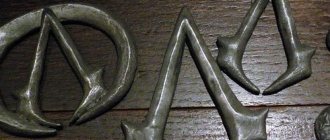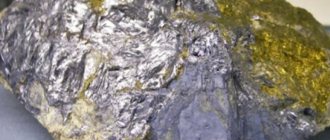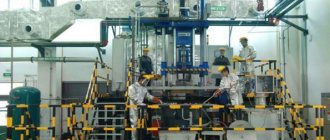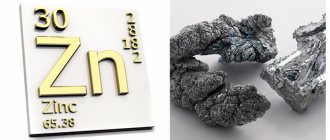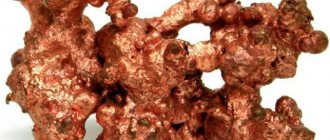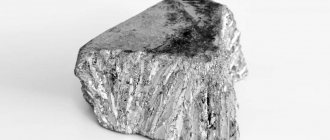Obtaining molybdenum
The raw materials from which metallic molybdenum is produced are molybdenum concentrates. They contain about 50% of this element. They also contain: sulfur ~ 30%, silicon oxide (up to 9%) and about 20% of other impurities.
The concentrate is pre-fired for additional oxidation. The process is carried out in two types of furnaces: multi-hearth or fluidized bed. Firing temperature 570 °C - 600 °C. The result is cinder - MoO3 and impurities.
In the next step, impurities are removed to obtain pure molybdenum oxide. Two methods are used:
- Sublimation at a temperature of 950 °C - 1100 °C.
- Chemical leaching. The essence of the method is that when interacting with ammonia water, impurities of copper and iron are eliminated and molybdenum carbide is obtained, which is crystallized by evaporation or neutralization. Next, the carbide is heated and maintained at temperatures up to 500°C. The output is pure MoO3 oxide, in which the impurity content is only 0.05%.
Molybdenum production is based on the reduction of MoO3. The process is carried out in two stages:
- In a tube furnace at a temperature of 550°C - 700°C, oxygen atoms are separated in a flow of dry hydrogen.
- Then the temperature rises to 900°C - 1000°C and final recovery occurs. The resulting metal is in powder form.
To obtain a monolithic metal, powder is melted or sintered. Melting is used when producing workpieces weighing more than 500 kg. The process is carried out in arc furnaces with a cooled crucible, into which a consumable electrode is supplied from previously sintered rods.
Obtaining molybdenum
Powder sintering is pressing in a hydrogen atmosphere at high pressure (2000-3000 atmospheres) and temperature (1000°C - 1200°C). The resulting bars are subjected to sintering at high temperatures equal to 2200°C - 2400°C. Subsequently, molybdenum is given the required shape through pressure treatment - forging, rolling, broaching.
Ferromolybdenum, which contains up to 60-70% molybdenum and the rest is iron, is widely used in industry. It is obtained by introducing molybdenum additives into steel. The alloy is produced by reducing cinder with iron silicate with the addition of steel filings and ferrous ore.
Being in nature
The content in the earth's crust is 3⋅10−4% by weight. Molybdenum is not found in free form. In the earth's crust, molybdenum is distributed relatively evenly. Ultramafic and carbonate rocks contain the least amount of molybdenum (0.4–0.5 g/t). The concentration of molybdenum in rocks increases as SiO2 increases. Molybdenum is also found in sea and river water, in plant ash, in coal and oil. The content of molybdenum in seawater ranges from 8.9 to 12.2 μg/l for different oceans and water areas. What is common is that waters near the shore and the upper layers are less enriched in molybdenum than waters at depth and away from the shore. The highest concentrations of molybdenum in rocks are associated with accessory minerals (magnetite, ilmenite, sphene), but the bulk of it is contained in feldspars and less in quartz. Molybdenum in rocks is found in the following forms: molybdate and sulfide in the form of microscopic and submicroscopic precipitation, isomorphic and dispersed (in rock-forming minerals). Molybdenum has a greater affinity for sulfur than for oxygen, and tetravalent molybdenum sulfide, molybdenite, is formed in ore bodies. A reducing environment and high acidity are most favorable for the crystallization of molybdenite. Under surface conditions, predominantly oxygen compounds MO6+ are formed. In primary ores, molybdenite is found in association with wolframite and bismuthin, with copper minerals (porphyry copper ores), as well as with galena, sphalerite and uranium pitch (in low-temperature hydrothermal deposits). Although molybdenite is considered a stable sulfide with respect to acidic and alkaline solvents, under natural conditions, with prolonged exposure to water and atmospheric oxygen, molybdenite is oxidized, and molybdenum can migrate intensively to form secondary minerals. This can explain the increased concentrations of molybdenum in sedimentary deposits - carbonaceous and siliceous-carbonaceous shales and coals.
About 20 molybdenum minerals are known. The most important of them are: molybdenite MoS2 (60% Mo), powellite CaMoO4 (48% Mo), molybdite Fe(MoO4)3 nH2O (60% Mo) and wulfenite PbMoO4.
Place of Birth
Large deposits of molybdenum are known in the USA, Mexico, Chile, Canada, Australia, Norway, and Russia. In Russia, molybdenum is produced at the Sorsk ferromolybdenum plant. More than 7% of the world's molybdenum reserves are located in Armenia, with 90% of them concentrated in the Kajaran copper-molybdenum deposit.
In space
An abnormally high molybdenum content is observed in stellar formations consisting of a red giant (or supergiant) with a neutron star inside—Landau-Thorn-Zhitkova objects.
Physical properties
The use of molybdenum depends on its properties and characteristics. The inherent physical properties of molybdenum are given below:
- metal type - high temperature melting;
- molybdenum color – lead;
- molybdenum density - 10.2 g/cm3;
- melting at a temperature of 2615°C;
- boiling at a temperature of - 4700°C;
- thermal conductivity - 143 W/(m K);
- thermal capacity - 0.27 kJ/(kgK);
- energy for melting - 28000 J/mol;
- energy for evaporation - 590000 J/mol;
- linear expansion, coefficient - 6·10-6;
- electrical resistance - 5.70 μOhm cm;
- calculated volume - 9.4 cm3/mol;
- shear force - 122·10·6 Pa;
- hardness - 125 HB;
- magnetic permeability -90·10-6.
This metal is not often subjected to turning, but processing is carried out with a standardized tool.
Content
- 1 History and origin of the name
- 2 Occurrence in nature 2.1 Deposits
- 2.2 In space
- 3.1 Genetic groups and industrial types of deposits
- 5.1 Isotopes
- 8.1 Nitrogen cycle
Chemical properties
Molybdenum, the chemical properties of which are given below, has the following characteristics:
- valence radius - 130·10-12 m;
- ionic radius - (+6e) 62 (+4e) 70·10-12 m;
- electrical negativity - 2.15;
- electric potential – 0;
- valence during oxidation - 2-3-4-5-6
- molybdenum valence – 6;
- oxidation onset temperature - 400°C;
- oxidation to MoO3 at a temperature of - 600°C and above;
- reaction with hydrogen is neutral;
- reaction temperature with chlorine – 250°C;
- reaction temperature with fluorine – room temperature;
- reaction temperature with sulfur – 440°C;
- reaction temperature with nitrogen is 1500°C.
With oxygen, the element forms two main oxides:
- MoO3 – white crystalline form
- MoO2 is silver in color.
Molybdenum MoS2
Solubility properties of molybdenum in chemical solutions: soluble in alkalis and acids when heated. This helps to obtain various compounds or purify it.
Tungsten.
Tungsten
(Wolframium) W - element of group VI, 6th period of the periodic system of D.I. Mendeleev, p.n. 74, atomic mass 183.85. Opened in 1781 by K. Scheele. Tungsten is rare in nature. Forms its own minerals - wolframite and scheelite; found as an impurity in the minerals tin, molybdenum, titanium. Tungsten is a light gray metal that is chemically resistant under normal conditions. At elevated temperatures, it reacts with oxygen, carbon and other elements. It reacts with fluorine at 20° C, and with other halogens when heated. Acids, with the exception of hydrofluoric and nitric acids, have no effect on tungsten. In compounds it exhibits variable valency. The most stable compounds are hex-valent tungsten. Tungsten is used for alloying steels, for the manufacture of hard alloys for incandescent filaments of electric lamps, heaters in electric furnaces, electrodes for welding, cathodes of generator lamps, and high-voltage rectifiers.
Molybdenum Processing
Processing of molybdenum is difficult due to its low viscosity at low temperatures. It also has low ductility, so the following methods are used for its processing:
- hot deformation:
- forging;
- rolling;
- broach;
- heat treatment;
- mechanical restoration.
When processing small workpieces, crimping machines are used. Large billets are rolled on small mills or shaped on broaching machines.
Appearance of molybdenum
If there is a need for machining by cutting, then machining of molybdenum is carried out with a tool made from high-speed steel grades. The sharpening of tool corners during turning should correspond to the sharpening angles for machining cast iron.
The heat treatment of molybdenum is characterized by high hardenability due to its content in steels. The hardening carried out increases the hardness and wear resistance of critical parts.
Production, deposits
Molybdenum is a rare metal. In nature, its presence in its pure form is impossible.
Almost two dozen molybdenum-containing minerals are known:
| Mineral | Ore-forming metal content |
| Molybdenite | 57-60% |
| Ferrimolybdite | 40-60% |
| Will command | 48% |
| Wulfenite | 27–46% |
| Zeirigit | Up to 24% |
Other molybdenum-containing ores (chillagite, comosite, kechlinite, jordisite and others) are not of interest for industrial use.
Significant metal deposits belong to:
- USA;
- Chile;
- Canada;
- Kazakhstan;
- Peru;
- China.
The ranking of molybdenum ore production is headed by China, the USA is in second place by a wide margin, and Chile is in third place.
The State Balance of Mineral Reserves of the Russian Federation lists 34 molybdenum deposits.
The origin of molybdenum ores is from skarn, greisen, and hydrothermal deposits.
The content of rare metal in the earth's crust is only 0.02%. But it is necessary for the existence of humans as a biological species. But there is suspiciously a lot of molybdenum in space. Red giants are especially rich in it - old stars, for which “everything is in the past.”
Application
About 3⁄4 of all rare earth metal produced is used as an alloying element in the production of steels. The remaining 1⁄4 part is used in pure form and in chemical compounds. It has found application in many industries.
- Space and aircraft manufacturing. Products made from molybdenum and its alloys are used for lining and manufacturing rocket heads and noses of aircraft flying at speeds above sound speed. Used as a structural material - this is the casing, and as a heat shield - the head part.
- Metallurgy. The use of molybdenum in foundry and metallurgy is due to its high hardenability. Consequently, strength, corrosion resistance, and toughness increase. In its alloys with cobalt or chromium, hardness increases noticeably. Critical parts are made from alloy steels with molybdenum additives. It is added to heat- and acid-resistant alloys. Therefore, most hot working tools are made from Mo alloy steels.
- Chemical industry. Various devices for the production of acids or their processing are made from materials with Mo that are acid-resistant. Furnace heaters containing a hydrogen environment are also made of molybdenum alloys. This metal can also be found in some varnishes, paints, enamels and thermally applied glazes. The metal is also used as a catalyst for chemical reactions.
- Radioelectronics. Mo is an indispensable material for the manufacture of electric lighting and electronic vacuum devices, among which radio tubes are known to many.
- Medicine. In medicine, the element is used in the manufacture of X-ray machines.
- Glass products. Because it melts at high temperatures, Mo is used in glass melting.
Biological role
The physiological significance of molybdenum for the animal and human body was first demonstrated in 1953, with the discovery of the influence of this element on the activity of the enzyme xanthine oxidase. Molybdenum promotes (makes it more effective) the work of antioxidants, including vitamin C. An important component of the tissue respiration system. Strengthens the synthesis of amino acids, improves nitrogen accumulation. Molybdenum is part of a number of enzymes (aldehyde oxidase, sulfite oxidase, xanthine oxidase, etc.) that perform important physiological functions, in particular, the regulation of uric acid metabolism. Molybdenum enzymes catalyze the hydroxylation of various substrates. Aldehyde oxidase oxidizes and neutralizes various pyrimidines, purines, and pteridines. Xanthine oxidase catalyzes the conversion of hypoxanthines to xanthines, and xanthines to uric acid. Sulfite oxidase catalyzes the conversion of sulfite to sulfate.
A lack of molybdenum in the body is accompanied by a decrease in the content of xanthine oxidase in tissues. With a lack of molybdenum, anabolic processes suffer, and a weakening of the immune system is observed. Ammonium thiomolybdate (soluble molybdenum salt) is a copper antagonist and disrupts its utilization in the body.
Nitrogen cycle
Molybdenum is part of the active site of nitrogenase, an enzyme for fixing atmospheric nitrogen (common in bacteria and archaea).
Microelement
Micro amounts of molybdenum are necessary for the normal development of organisms; it is used as part of microelement nutrition, in particular, for berry crops.
Affects reproduction (in plants).
Grades of molybdenum and its alloys
Molybdenum alloys are more often used in industry than pure metal. Among them are:
- metal with a purity of 99.96%, which is used for the production of electronic devices, is labeled MCH;
- metal obtained by melting under vacuum is marked molybdenum MChVP;
- for the production of wire used in light sources, metal under the MRN brand is used, where its content is 99.92%;
- when adding an additive, silicon alkali, molybdenum is marked MK;
- zirconium (Zr) or titanium (Ti) is introduced into Mo - grade CM;
- with the introduction of rhenium - MR;
- tungsten with Mo – MV.


